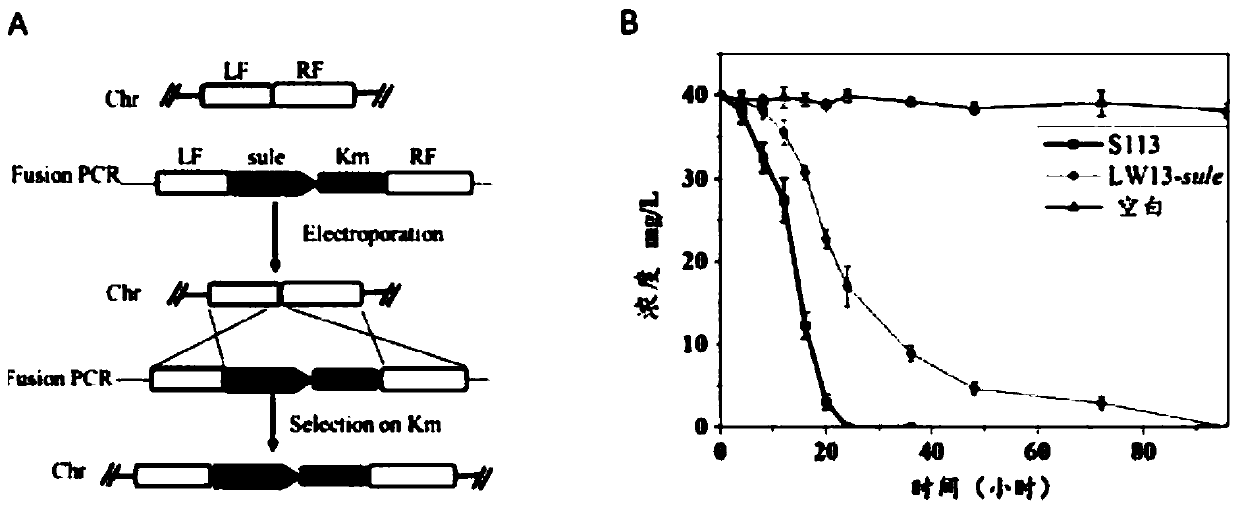Method for eliminating organic pollutant residues in soil by utilizing genetically engineering modified methane-oxidizing bacteria
A technology of genetically engineered bacteria and methane oxidizing bacteria, applied in the field of eliminating residual organic pollutants in soil, can solve problems such as unusable, and achieve the effect of promoting survival and reproduction
- Summary
- Abstract
- Description
- Claims
- Application Information
AI Technical Summary
Problems solved by technology
Method used
Image
Examples
Embodiment 1
[0025] The construction of embodiment 1 genetically engineered bacteria
[0026] In order to integrate the sulfonylurea herbicide hydrolase gene sulE into the chromosome of strain Methylomonas sp.LW13, first, Hansschlegelia zhihuaiae S113 (DSM 18984 T ) genomic DNA as a template with primers sule-F and sule-R to amplify fragment 1 carrying sulE, and use plasmid pAWP89 (Puri A W et al., Applied and Environmental Microbiology, 2015, 81(5): 1775-1781.doi : 10.1128 / AEM.03795-14) as a template with primers km-F and km-R to amplify fragment 2 carrying the kanamycin resistance gene, with the genomic DNA of bacterial strain Methylomonassp.LW13 as a template, with primers LF- Fragment 3 was amplified with F and LF-R, and fragment 4 was amplified with primers RF-F and RF-R; then, by fusion PCR method with primers LF-F and RF-R (Shevchuk NA et al., Nucleic Acids Research ,2004,32(2),e19.doi:10.1093 / nar / gnh014) connected these four fragments into a fragment according to the sequence of 3...
Embodiment 2
[0027] The fermentation culture of embodiment 2 engineering bacteria LW13-sulE
[0028] In order to obtain the cells of the engineering bacteria LW13-sulE, first, the bacteria were streaked on the solid NMS medium, and the streaked plate was placed in a sealable jar, filled with 30% methane (methane to air ratio) Culture at 30°C for 3 days; then transfer the cells on the solid NMS medium to the liquid NMS medium, place the liquid culture in a sealable culture bottle, and fill with 30% methane (the ratio of methane to air) Then culture at 30° C. for 3 days; finally collect the cells by centrifugation (5000 rpm, 10 minutes).
Embodiment 3
[0029] Embodiment 3 repairs the soil polluted by bensulfuron-methyl with engineering bacteria LW13-sulE
[0030] Bensulfuron-methyl is a typical sulfonylurea herbicide. Three concentrations of benzazine were added to the soil, 0mg / kg, 0.4mg / kg (the maximum recommended dosage in the field) and 4mg / kg (10 times the maximum recommended dosage in the field), to obtain three kinds of soil samples. Then, each soil sample was treated with three treatments: no inoculation, inoculation with strain LW13 and inoculation with engineering bacteria LW13-sulE. In the treatment of inoculation, the inoculation amount is 10 5CFU / g soil. Place the inoculated soil in a sealable tank, fill it with 30% methane (the ratio of methane to air) and cultivate it at room temperature for 10 days. During this period, shake the device once every other day to ensure that the soil is well ventilated, and change it every two days Gas, to ensure sufficient gas volume. After remediation, bioassay (planting pl...
PUM
 Login to View More
Login to View More Abstract
Description
Claims
Application Information
 Login to View More
Login to View More - Generate Ideas
- Intellectual Property
- Life Sciences
- Materials
- Tech Scout
- Unparalleled Data Quality
- Higher Quality Content
- 60% Fewer Hallucinations
Browse by: Latest US Patents, China's latest patents, Technical Efficacy Thesaurus, Application Domain, Technology Topic, Popular Technical Reports.
© 2025 PatSnap. All rights reserved.Legal|Privacy policy|Modern Slavery Act Transparency Statement|Sitemap|About US| Contact US: help@patsnap.com



